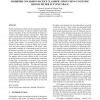910 search results - page 17 / 182 » Counting People in Groups |
COLING
2008
13 years 11 months ago
2008
Semantic relatedness between words is important to many NLP tasks, and numerous measures exist which use a variety of resources. Thus far, such work is confined to measuring simil...
COMBINATORICS
2007
13 years 9 months ago
2007
We define an excedance number for the multi-colored permutation group i.e. the wreath product (Zr1 × · · · × Zrk ) Sn and calculate its multi-distribution with some natural ...
COMBINATORICS
1998
13 years 9 months ago
1998
We show that the moments of the trace of a random unitary matrix have combinatorial interpretations in terms of longest increasing subsequences of permutations. To be precise, we s...
PDCN
2007
13 years 11 months ago
2007
Packet classification continues to be an important challenge in network processing. It requires matching each packet against a database of rules and forwarding the packet accordi...
CSCW
2010
ACM
14 years 6 months ago
2010
ACM
In this work we examine nine different sources for user similarity as reflected by activity in social media applications. We suggest a classification of these sources into three c...

